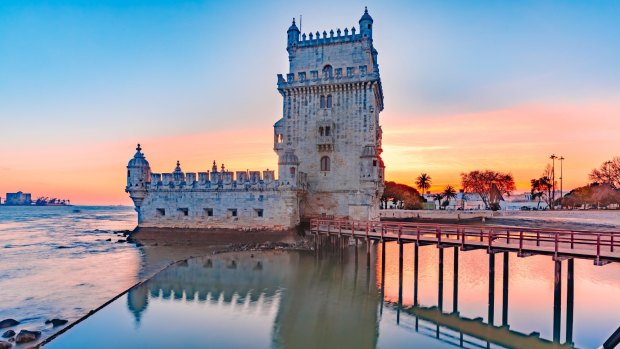This was published 5 years ago
Travel tips and advice for Belem, Portugal: What to see and do

Belem Tower in Lisbon at sunset.Credit: Alamy
Some rulers really justify their descriptions. Ethelred the Unready was decidedly that, especially when Vikings invaded, and Ivan could be really Terrible. Vlad? He certainly enjoyed the whole impaling thing.
Portugal's Prince Henry the Navigator, on the other hand, could just as easily have been known as Henry the Stay-At-Home.
He was never king, never sailed any distance, never discovered anything of any importance and yet has gone down in history as the "Godfather of the Golden Age of Discovery".
So how did such an ordinary guy win such a positive moniker?
Here in Lisbon, there's a chance to discover the answer. The best place to start is Belem, the historic part of Lisbon most closely associated with Henry, who was the third son of Portugal's King John I and Philippa of Lancaster, daughter of England's John of Gaunt.
The Tagus (Rip Tejo in Portuguese) is the longest river on the Iberian peninsula and at its widest and mightiest at Belem, about two kilometres west of the huge April 25th Bridge which celebrates the bloodless overthrow of Antonio Salazar's dictatorship in 1974's Carnation Revolution.
"Belem", derived from the Portuguese word for Bethlehem, has always been associated as much with Christianity as with naval power.
During Henry's time, Belem was well-established as Lisbon's principal dockyard, teeming with sailmakers, shipwrights, provisioners and prostitutes.
Today, the perfect way to get your bearings is to visit the observation deck of the Monument to the Discoveries. For €5 an elevator will whisk you 50 metres above ground up for a bird's-eye view of Belem. The best view, however, is from ground level. Unveiled in 1960 – Salazar was the longest ruling dictator in Europe at the time – to mark the 500th anniversary of Henry's death, it's a superb piece of totalitarian art; worthy of anything Mussolini or Stalin might have approved.
It leans out towards the Tagus like the prow of a caravel (the typical Portuguese ship sent out to explore the world), with sculptures depicting Portugal's contribution to world knowledge. Leading a crew that includes Vasco da Gama and Ferdinand Magellan is "our Henry" who, according to the monument's official website "discovered the Azores, Madeira and Cape Verde".
Do admire the wondrous marble mozaic at the foot of the memorial. It was a gift of then-apartheid South Africa – Bartolomeu Dias was the first European explorer to reach the Cape of Good Hope in 1488 – and shows an atlas surrounded by a compass, pointing to colonies new.
Now head west along the promenade to the main historical edifice identified with Henry: Belem Tower. A World Heritage site, along with the neighbouring Jeronimos Monastery, Torre de Belem is a peculiar fortress built to prevent pirates and brigands sailing up the Tagus. Admittedly, the coastline has altered marginally since and the Tower is no longer on an island.
You only need to take one look at the tower to see why it was never effective. Were buccaneers and invaders meant to be scared by all that elaborate, refined "Manueline" architecture? King Manuel the Fortunate appointed his military architect to build the tower on a basalt outcrop a short distance from the riverbank. It was completed in 1519.
Have you noticed the discrepancy yet? Henry the Navigator died nearly 60 years before the Belem Tower was built.
Which brings us to the monastery. In 1497 (four decades after Henry died), Vasco da Gama and his crew prayed at the Hermitage of Reselo before setting off in search of the Orient the next morning. It proved a profitable voyage, enabling Manuel the Fortunate to order the construction of Jeronimos Monastery, based on a five per cent tax on imports from Africa and Asia.
Da Gama's tomb, in neo-Manueline style, is one of the highlights of a monastery that is regarded as one of western Europe's architectural gems.
Henry's tomb? Nowhere to be seen.
Did Henry establish the world's first school of navigators at Sagres? Probably not. Did he discover anything? No, though he did sail to modern-day Morocco in an ill-advised military adventure. Was he passionate about maps, exploration, funding daring adventures with a view to expanding Portugal's global profile? Definitely yes.
If this is getting too confusing, don't leave Belem without tasting its most famous delicacy. Pasteis de Belem (pasteisdebelem.pt), a bakery established in 1837, claims to have the original recipe from the monks from the neighbouring monastery. In Australia, we know these succulent custard-filled pastries as Portuguese tarts. In Henry's Belem, that phrase would have had an altogether different meaning.
Regent Seven Seas Cruises offers a range of Europe itineraries that include Lisbon, including an 11-night Iberian Discovery cruise departing November 12, with fares from $9320 a person. See rssc.com
Steve Meacham was a guest of Regent Seven Seas Cruises.
Sign up for the Traveller Deals newsletter
Get exclusive travel deals delivered straight to your inbox. Sign up now.